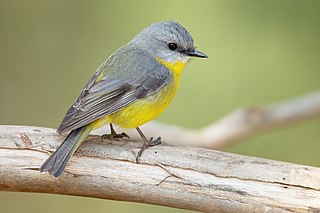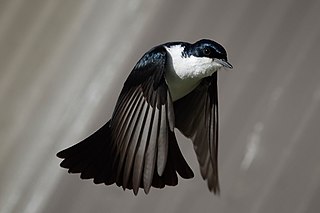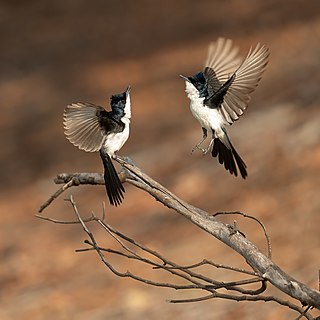Related Research Articles

Currawongs are three species of medium-sized passerine birds belonging to the genus Strepera in the family Artamidae native to Australia. These are the grey currawong, pied currawong, and black currawong. The common name comes from the call of the familiar pied currawong of eastern Australia and is onomatopoeic. They were formerly known as crow-shrikes or bell-magpies. Despite their resemblance to crows and ravens, they are only distantly related to the corvidae, instead belonging to an Afro-Asian radiation of birds of superfamily Malaconotoidea.

The eastern yellow robin is an Australasian robin of coastal and sub-coastal eastern Australia. The extent of the eastern yellow robin's residence is from the extreme southeast corner of South Australia through most of Victoria and the western half of New South Wales and north as far as Cooktown. Tropical Northern Queensland birds are mainly restricted to the warm heights of the Great Dividing Range.

The spotted pardalote is one of the smallest of all Australian birds at 8 to 10 centimetres in length, and one of the most colourful; it is sometimes known as the diamondbird. Although moderately common in all of the reasonably fertile parts of Australia it is seldom seen closely enough to enable identification.

The scarlet robin is a common red-breasted Australasian robin in the passerine bird genus Petroica. The species is found on continental Australia and its offshore islands, including Tasmania. The species was originally split in 1999 by Schodde and Mason, and as the original collection by Gmelin was from Norfolk Island, this retained the name of multicolor, and is now known as the Norfolk robin.

The restless flycatcher, or restless myiagra, is a passerine bird in the family Monarchidae; it is also known as the razor grinder or scissors grinder because of its distinctive call. It is a native of eastern and southern Australia. Populations in New Guinea and northern Australia, which were at one time considered to be a subspecies, are now accepted as a separate species, the paperbark flycatcher. It is a small to medium-sized bird and has similar colouring to the willie wagtail.

The black-backed butcherbird is a species of bird in the family Artamidae. It is found in southern New Guinea and Cape York Peninsula.
The northern scrub robin is a species of bird in the family Petroicidae. It is found in northern Cape York Peninsula. It was found to be genetically distinct from the Papuan scrub robin, which were thought to be members of the same species.

The grey-crowned babbler is a species of bird in the family Pomatostomidae. It is found in Australia, Indonesia, and Papua New Guinea. Its natural habitats are temperate forests and subtropical or tropical moist lowland forests.

The chowchilla is a passerine bird in the family Orthonychidae. It is endemic to Australia.

The Lord Howe silvereye, also known as the Lord Howe white-eye, Lord Howe Island white-eye or, locally, as the "Little Grinnell", is a small bird in the white-eye family, Zosteropidae. It is a subspecies of the silvereye, though sometimes considered a full species. It is endemic to Lord Howe Island in the Tasman Sea, part of New South Wales, Australia.

The Arafura fantail, sometimes known as the wood fantail, inhabits the Lesser Sunda Islands, the northern coast of Australia from the Kimberley to the western side of the Cape York Peninsula, including subcoastally in the Top End of the Northern Territory, and southern New Guinea. It is similar to the rufous fantail, from which it has been split taxonomically but, apart from minor overlap in the eastern Moluccas, their geographic ranges are discrete. It is generally duller than the rufous fantail with the rufous colouration more restricted.

The Lord Howe fantail, also known as the Lord Howe Island fantail or fawn-breasted fantail, was a small bird in the fantail family, Rhipiduridae. It is an extinct subspecies of the New Zealand fantail. It was endemic to Lord Howe Island in the Tasman Sea, part of New South Wales, Australia.

The Lord Howe parakeet, also known as the Lord Howe red-fronted parakeet, is an extinct parrot endemic to Lord Howe Island in the Tasman Sea, part of New South Wales, Australia. It was described as full species by Tommaso Salvadori in 1891, but subsequently it has been regarded as subspecies of the red-crowned parakeet. In 2012, the IOC World Bird List recognised it as species.

The Lord Howe currawong, Lord Howe Island currawong or Lord Howe pied currawong, is a large and mainly black passerine bird in the family Artamidae. It is endemic to Lord Howe Island in the Tasman Sea, part of New South Wales, Australia, and is a threatened subspecies of the pied currawong.

The Lord Howe golden whistler, also known as the Lord Howe whistler or Lord Howe Island golden whistler, and locally as the “robin” or “yellow robin”, is a small bird in the whistler family, Pachycephalidae. It is a subspecies of the Australian golden whistler that is endemic to Lord Howe Island in the Tasman Sea, part of New South Wales, Australia.
Richard Schodde, OAM is an Australian botanist and ornithologist.

The Kimberley honeyeater is a bird in the honeyeater family, Meliphagidae. It was formerly lumped with the white-lined honeyeater but, based on a genetic analysis, it is now considered a separate species. Articles published in 2014 and 2015 provided evidence that the Kimberley and white-lined honeyeaters differ not only genetically, but also in song and foraging ecology. The specific epithet honours the Australian chemist and ornithologist Dr Julian Ralph Ford (1932-1987).

The paperbark flycatcher, also known as the little restless flycatcher, is a passerine bird in the family Monarchidae. It occurs in tropical woodland and riverine habitats of northern Australia and southern New Guinea. Previously, some authorities lumped the paperbark flycatcher as a distinctive subspecies of the restless flycatcher of southern and eastern Australia, with which it forms a superspecies.
The Roper River scrub robin, also known as the allied scrub robin, is a putative subspecies of the northern scrub robin, a bird in the Petroicidae, or Australasian robin family. Whether it ever existed is doubtful; if it did it is almost certainly extinct.

Spilopelia is a genus of doves that are closely related to Streptopelia, yet distinguished from them by differences in morphology and behavior. Some authors have argued that Stigmatopelia is the valid name as it appears in an earlier line although also erected by the Swedish zoologist Carl Sundevall, but Richard Schodde and Ian J. Mason in their zoological catalogue of Australian birds chose Spilopelia citing clause 24(b) of the International Code of Zoological Nomenclature (ICZN) which supports the decision of the first reviser. The name Spilopelia combines the Ancient Greek spilos meaning "spot" and peleia meaning "dove".
References
- ↑ "Mr Ian Mason: documenting Australia's wildlife". CSIRO. Retrieved 2 January 2010.